Digital Poster
Novel & Multiple Contrast Techniques
Joint Annual Meeting ISMRM-ESMRMB & ISMRT 31st Annual Meeting • 07-12 May 2022 • London, UK

| Computer # | ||||
|---|---|---|---|---|
1523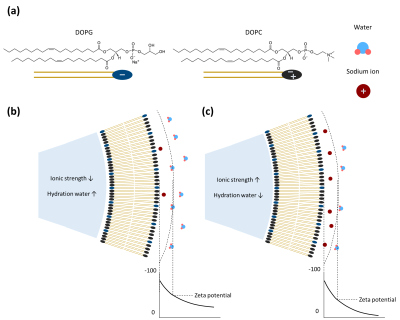 |
73 | The electric potential of lipid vesicle surfaces affects T2 and magnetization transfer
Kyeongseon Min1, Jongho Lee1, and Jang-Yeon Park2,3
1Department of Electrical and Computer Engineering, Seoul National University, Seoul, Korea, Republic of, 2Department of Biomedical Engineering, Sungkyunkwan University, Suwon, Korea, Republic of, 3Department of Intelligent Precision Healthcare Convergence, Sungkyunkwan University, Suwon, Korea, Republic of
In this study, the effect of the electric potential of lipid vesicle surfaces on MR relaxation times and magnetization transfer was investigated. Negatively charged multilamellar vesicles were formed, and their surface potential was adjusted by changing the sodium ion concentration. While the zeta potential changed from -57.0 mV to –21.6 mV, T2 increased from 48.2 ms to 67.4 ms, PSR decreased from 5.5% to 5.0%, kmf decreased from 82.7 Hz to 40.6 Hz, and T2b increased from 177.8 μs to 189.1 μs. These observations are expected to be utilized to image action potential generated in white matter.
|
||
1524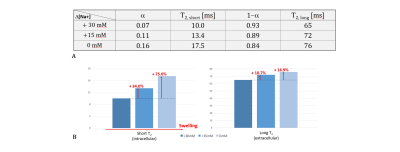 |
74 | Cell swelling induces measurable changes in T2 relaxation time
Seong-min Kim1, Kyeongseon Min2, and Jang-Yeon Park1,3
1Department of Biomedical Engineering, Sungkyunkwan University, Suwon, Republic of Korea, Suwon, Korea, Republic of, 2Laboratory for Imaging Science and Technology, Department of Electrical and Computer Engineering, Seoul National University, Seoul, Republic of Korea, Seoul, Korea, Republic of, 3Department of Intelligent Precision Healthcare Convergence, Sungkyunkwan University, Suwon, South Korea, Suwon, Korea, Republic of
To find novel contrast mechanisms of neuronal activity, our group previously demonstrated using in vitro cells that changes in membrane potential induces changes in MR parameters. There are two plausible factors that may contribute when the membrane potential changes: the dynamics of hydration water, and cell swelling. In this study, we investigated if cell swelling can contribute to changes in T2 under a constant membrane potential using non-excitable cells. As a result, we found that cell swelling induces measurable changes. As the cell size increased, the short T2 component caused by the intracellular water increased and vice versa.
|
||
1525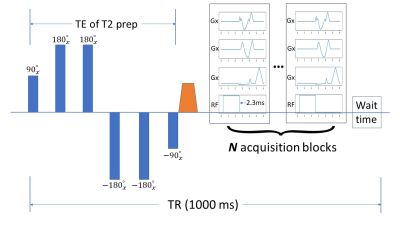 |
75 | T2-weighted Free-breathing 3D Abdominal Imaging Using Magnetization Prepared SPGR
Zheng Zhong1, Xiaozhi Cao1, Congyu Liao1, Zhitao Li1, Ali Syed1, Kawin Setsompop1, and Shreyas S. Vasanawala1
1Radiology, Stanford University, Stanford, CA, United States
T2-weighted imaging is conventionally obtained using multi-slice 2D or 3D fast spin-echo (FSE) sequences. However, FSE suffers from severe specific absorption rate (SAR) issue and motion artifact particularly in the abdomen. A potential approach to address these challenges is using T2-prepared 3D SPGR sequence with a non-Cartesian trajectory such as cones. In this study, we proposed a T2-prepared 3D-cones sequence to achieve T2-weighted abdominal imaging with free breathing. The feasibility of the technique was tested on both healthy subjects and patients.
|
||
1526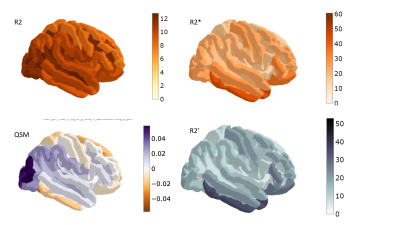 |
76 | Iron, myelin and cortical brain ageing: investigating correlations between QSM, R2, R2* and R2'
Ana-Maria Oros-Peusquens1, Luis Hau1, and N. Jon Shah1,2,3,4
1Institute of Neuroscience and Medicine INM-4, Research Centre Juelich, Juelich, Germany, 2Department of Neurology, RWTH Aachen University, Aachen, Germany, 3Faculty of Medicine, JARA, RWTH Aachen University, Aachen, Germany, 4Institute of Neuroscience and Medicine 11, INM-11, JARA, Research Centre Juelich, Juelich, Germany
Understanding MR contrast/relaxation in vivo based on myelin and iron content is an on-going endeavour. We study the age dependence and correlation of QSM, R2, R2’ and R2* in vivo with whole brain coverage, investigating whether the interplay between demyelination and iron increases explains changes in these four qMRI parameters. The observations suggest that age-related influences proceed mostly by the intra-cellular iron effect on QSM and demyelination effect on R2.
|
||
1527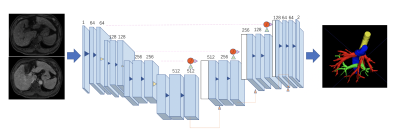 |
77 | MRI-based liver vascular morphology and surface nodularity quantification for assessment of portal hypertension Video Not Available
Yikun Wang1, Ruokun Li1, Jiahao Zhou1, Chengyan Wang2, and Fuhua Yan1
1Ruijin Hospital, Shanghai Jiaotong University School of Medicine, Shanghai, China, 2Human Phenome Institute, Fudan University, Shanghai, China
Hepatic venous pressure gradient (HVPG) measurement is the standard technique of assessing portal pressure. Portal hypertension is mainly caused by increased intrahepatic resistance to portal blood flow related to structural changes, including fibrosis and vascular distortion. Here, we used dynamic contrast-enhancement (DCE) MRI to quantify segmented liver contours and vascular morphology in evaluating portal pressure. Our study showed the MRI measurements correlated well with HVPG measurement. A non-invasive prediction model combining liver vascular morphology and liver surface nodularity (LSN) can potentially be used to assess clinically significant portal hypertension (CSPH).
|
||
1528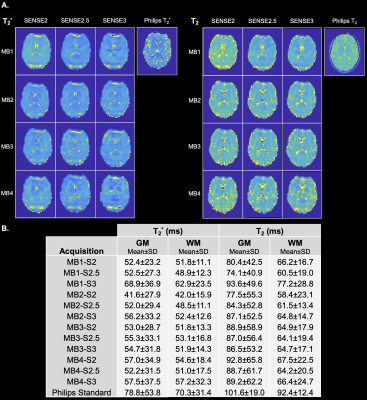 |
78 | Optimization of combined spin- and gradient-echo EPI in fMRI via in- and through-plane acceleration
Elizabeth G. Keeling1,2, Maurizio Bergamino1, Sudarshan Ragunathan1, C. Chad Quarles1, and Ashley M. Stokes1
1Barrow Neurological Institute, Phoenix, AZ, United States, 2Arizona State University, Tempe, AZ, United States
BOLD-fMRI is widely used to study brain activity but suffers from signal dropout near air-tissue interfaces and lack of sensitivity to microvasculature. A combined spin- and gradient-echo (SAGE) acquisition, previously implemented for perfusion MRI, may be able to reduce signal dropout and provide sensitivity to microvasculature for fMRI applications. SAGE-fMRI presents its own challenges, namely lack of full brain coverage and poor temporal and spatial resolution. These challenges can be overcome by combining in-plane and through-plane acceleration factors. This study aims to optimize the SAGE-fMRI protocol, balancing acceleration of acquisition with image quality.
|
||
1529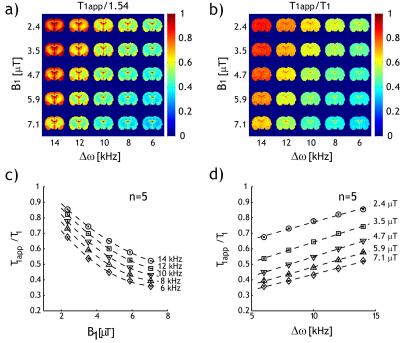 |
79 | Simplified fast multislice T1app mapping for improved cerebral blood flow arterial spin labeling MRI
Yang Ji1, Dongshuang Lu1, and Phillip Zhe Sun1,2
1Athinoula A. Martinos Center for Biomedical Imaging, Massachusetts General Hospital, Harvard Medical School, Boston, MA, United States, 2Department of Radiology and Imaging Sciences, Emory University School of Medicine, Atlanta, GA, United States
Given the association between MT and longitudinal relaxation rate (1/T1), we hypothesized that T1app, under RF saturation, can be estimated from T1 to improve CBF quantification. Using Wistar rats, we showed that the T1app over T1 ratiometric map (i.e., T1app/T1) is homogeneous despite large regional variation in T1 and T1app maps. Therefore, we postulated that T1app map could be estimated from the routine T1 map instead of T1app, which is cumbersome and not straightforward. A fast T1app estimation provides satisfactory Cerebral blood flow (CBF) measurement across the brain, not affected by the concomitant MT effect.
|
||
1530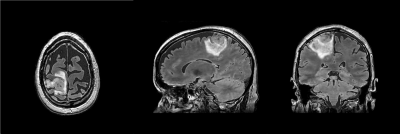 |
80 | Deep learning based image reconstruction for improved 3D multiparameter mapping and synthetic MR imaging
Ken-Pin Hwang1, Kim O. Learned2, Naoyuki Takei3, R. Marc Lebel4, Peter Johansson5, David Shin6, Xinzeng Wang7, Catharina Petersen5, Marcel Warntjes5, Suchandrima Banerjee6, and Linda Chi2
1Department of Imaging Physics, The University of Texas M.D. Anderson Cancer Center, Houston, TX, United States, 2Department of Neuroradiology, The University of Texas M.D. Anderson Cancer Center, Houston, TX, United States, 3GE Healthcare, Hino, Japan, 4Global MR Applications and Workflow, GE Healthcare, Calgary, AB, Canada, 5SyntheticMR, AB, Linkoping, Sweden, 6GE Healthcare, Menlo Park, CA, United States, 7GE Healthcare, Houston, TX, United States Brain data with high grade glioma were acquired with a 3D multiparameter mapping sequence and reconstructed with a novel deep learning based method (DL Recon). Synthetic images created from maps fitted to the reconstructed images were rated by experienced radiologists for image quality and diagnostic utility. Images from the DL Recon workflow consistently rated equal to or better than those created from conventional reconstruction. We find that the SNR and resolution benefits of 3D DL Recon extend to improve the resulting relaxation maps and subsequent synthetic images. |
||
1531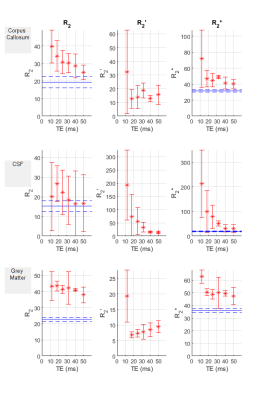 |
81 | GESSE Measurements at varying spin echo times in human brain at 7T
Ross Shaw1, Penny Gowland2, and Richard Bowtell3
1Physics, University of Nottingham, Nottingham, United Kingdom, 2University of Nottingham, Nottingham, United Kingdom, 3SPMIC, University of Nottingham, Nottingham, United Kingdom Simultaneous measurements of R2 and R2’ using the Gradient Echo Sampling of a Spin Echo (GESSE) sequence were made at multiple spin echo times in four volunteers. Secondary measurements of R2 and R2* were made using classical Spin Echo and Gradient Echo approaches. The variation in measured relaxation rates are explored and show a general overestimation of transverse relaxation in white and grey matter when measured with GESSE suggesting a lack of complexity in the model used to describe the GESSE signal. |
||
1532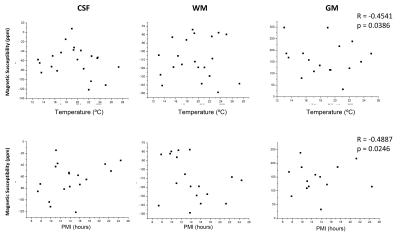 |
82 | Effect of post mortem interval and body temperature on tissue susceptibility
Fábio Seiji Otsuka1, Khallil Chaim2, Maria Otaduy2, and Carlos Salmon1
1InBrain, Departamento de Física, Faculdade de Filosofia, Ciências e Letras de Ribeirão Preto, Universidade de São Paulo, Ribeirão Preto, Brazil, 2Departamento de Radiologia e Oncologia, Faculdade de Medicina, Universidade de Sao Paulo, São Paulo, Brazil
On this study, the impact of temperature and postmortem interval (PMI) on QSM were evaluated for a total of 21 subjects. Temperature and PMI were correlated with values from CSF, white matter (WM) and gray matter (GM). Only the GM presented a significant correlation with both temperature and PMI.
|
||
1533 |
83 | Generating MRI reporter genes using a Protein Optimizing Evolving Tool (POET)
Alexander Robert Bricco1, Illiya Miralavy1, Shaowei Bo2, Or Perlman3, Christian Farrar3, Mike McMahon2, Wolfgang Banzhaf1, and Assaf Gilad1
1Michigan State University, East Lansing, MI, United States, 2Johns Hopkins University, Baltimore, MD, United States, 3Harvard Medical School, Boston, MA, United States
Reporter genes for MRI allow for the non-invasive observation and evaluation of gene and cell therapies which are being rapidly developed. Traditional methods of gene optimization failed to improve reporter gene quality. We developed and employed a novel machine learning program called the Protein Optimizing Evolving Tool (POET). Using POET we have discovered peptides which provide more contrast than prior efforts and also display properties that challenge prior knowledge on the functions of these genes.
|
||
1534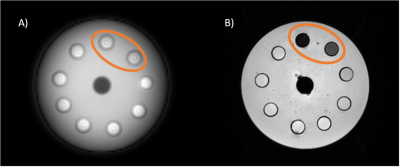 |
84 | Iron Imaging with 3D Multi-Gradient Recalled Echo (3D-mGRE) and 3D Ultra-short Echo (3D-UTE) Sequences: A Phantom Comparison Study
Humberto Monsivais1, Xin Shen2, Antonia Susnjar2, Ali Caglar Özen3, Serhat Ilbey 3, Mark Chiew 4, Aparna Karnik5, Uzay Emir1,2, and Ulrike Dydak1,6
1School of Health Sciences, Purdue University, West Lafayette, IN, United States, 2Weldon School of Biomedical Engineering, Purdue University, West Lafayette, IN, United States, 3Department of Radiology, Medical Physics, University of Freiburg, Freiburg, Germany, 4Wellcome Centre for Integrative Neuroimaging, University of Oxford, England, United Kingdom, 5Elmore Family School of Electrical and Computer Engineering, Purdue University, West Lafayette, IN, United States, 6Department of Radiology and Imaging Sciences, Indiana University School of Medicine, Indianapolis, IN, United States
This phantom study aimed to compare a conventional multi-gradient recalled echo (mGRE) sequence and an ultra-short echo (UTE) with a novel 3D rosette k-space trajectory for iron (Fe) detection and quantification. Conventional mGRE imaging may underestimate massive Fe load due to the long echo times (TEs). Advanced UTE techniques with TEs 10-200 times shorter than conventional mGRE sequences can capture fast signal decay caused by high Fe content. Our preliminary results show that both sequences yield a strong linear relationship between R2* values and Fe concentrations, with the 3D-UTE results aligning more with expected R2* values for high Fe concentrations.
|
||
The International Society for Magnetic Resonance in Medicine is accredited by the Accreditation Council for Continuing Medical Education to provide continuing medical education for physicians.